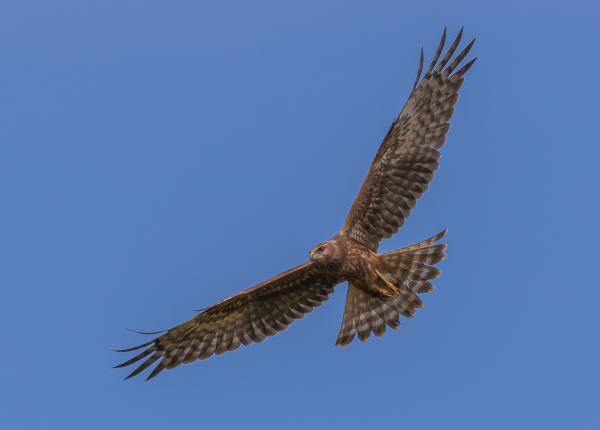Did You Know?
- The Malagasy Harrier is known by several other names including: Madagascar Harrier, Madagascar Marsh-harrier, and Malagasy Marsh-harrier.
- One Malagasy Harrier was documented feeding on the eggs of a waterbird (likely a rail or a gallinule).
How The Peregrine Fund is Helping
The Peregrine Fund is working tirelessly in Madagascar to save habitats and biodiversity. Three of 24 Malagasy raptor species are endangered, including the Malagasy Harrier. One of the most important actions we can take to save this species is the preservation of suitable habitats. In 2015, after years of working with local communities and government, The Peregrine Fund helped create three new areas which were given status as "National Protected Areas." This victory has increased protected habitat by 190,000 hectares and will provide protection for an untold number of endangered species.
Where They Live
The Malagasy Harrier is found on the island nation of Madagascar and on the Comoro Islands in the Indian Ocean, from sea level to about 1,800 meters above sea level.
The Malagasy Harrier inhabits marshy and wet areas of all kinds, including rice paddies, shady plantations, and mangroves. However, in the Comoros, there aren't that many marshy habitats around. So this harrier has had to adapt to living in much drier habitats such as savannas, grasslands and even in cultivation fields.
What They Do
Harriers, in general, are some of the most beautiful raptor species in the world, particularly while soaring. In fact, harriers are famous for their graceful, low flights on dihedral wings - wings held up to form a "v". The Malagasy Harrier is no exception. It is a stunning bird and, like the Northern Harrier, the male and female differ in coloration. This is known as sexual dimorphism. In the case of the Malagasy Harrier, the male has a dark black back, a slate-grey head and white streaks along its breast. The female is browner, overall. They both have bright yellow eyes and a distinctive facial disk.
Right about now, you might be asking yourself what exactly is a facial disk? A facial disk is composed of feathers that form a circle around its face. The disk can be lifted or lowered at will. When the feathers of the facial disk are raised, they help direct sounds to the bird's ears. To see how this works, cup your hands behind your ears and listen. You might notice that whatever you are listening to seems louder. When a Malagasy Harrier is hunting over dense grass or other vegetation, it listens for the sounds of its prey scurrying below and knows where to aim its sharp talons.
The Malagasy Harrier is a diurnal raptor, meaning it is active during the day and rests at night.
Like most raptor species, the Malagasy Harrier is a great defender of its nesting territory. It will work hard to prevent other harriers and predators from getting too close. Their defense calls have been described as "ouek" and "kekekekeke."
Why They Need our Help
There are several threats to the Malagasy Harrier, including the conversion of marshes into rice fields, uncontrolled fires in savannas and grasslands, collection of young from nests for human consumption, and poaching. Up until 2012 the species was considered Vulnerable by BirdLife International. Today, it has been uplisted to Endangered.
What They Eat
The Malagasy Harrier enjoys a diet of small vertebrates including birds, such as the Madagascar Partridge, rodents, turtles, frogs, snakes and chameleons. It also feeds largely on insects. Researchers observed one attack a Hottentot Teal—a type of duck—that had been shot, and another attempted to capture a half-grown chicken in a village. Like other harriers, it forages by flying low over vegetation and capturing prey by dropping rapidly to the ground and grasping its quarry in its talons.
Nest, Eggs, and Young
Before breeding begins, the male and female Malagasy Harrier engage in beautiful courtship activities including aerial displays performed by the males, vocalizations, food exchanges, and flights performed by both members of the pair. Madagascar Program Director Dr. Lily-Arison René de Roland described this exchange: "Aerial flight displays began with a spiraling, ascending flight by the male, then progressed to a fast hard flapping flight with steep undulations and then to a rapid descending spirals with "koue" vocalizations." He also described pair-formation flights in this way: "Pair-formation flights involved the male and female flying slowly together in their territory and sometimes stalling and grabbing at the other member of the pair."
Though more studies need to be made, preliminary observations have revealed that the male does the majority of the nest-building. He builds a nest platform made of green plant and dried twigs, often from pine or eucalyptus trees. The nest is constructed on the ground or in low vegetation, most often in marshes.
When the time is right, the female will lay 3–5 white eggs. She is responsible for all of the incubation, meaning she needs to sit on her eggs to keep them warm and safe for the roughly 32–34 days the embryos need to develop. While the female is busy caring for her eggs, the male is bringing food to the nest for the female and helping to defend the nest against predators.
When the nestlings hatch they are small and covered in fluffy down. The female remains on or very close to the nest to ensure her young continue to be safe as they grow into healthy fledglings. While the female is holding down the fort, the male is off working hard to find food for his female and his offspring. When he arrives in the nest area with prey, he often vocalizes to the female to alert her of his arrival. The female responds back with vocalizations of her own. Prey exchanges are often conducted in mid-air, with the female taking the prey directly from the male's talons.
When the nestlings are a bit older, around 24 days, the female will also leave the nest to help the male find food. The nestlings will continue to grow and gain strength and when they are about 42–45 days old then will fledge, or fly for the first time. When the young are around 70 days old, they will disperse from their natal territory.
References:
del Hoyo, J., N. Collar, J. S. Marks, and C. J. Sharpe (2020). Madagascar Harrier (Circus macrosceles), version 1.0. In Birds of the World (J. del Hoyo, A. Elliott, J. Sargatal, D. A. Christie, and E. de Juana, Editors). Cornell Lab of Ornithology, Ithaca, NY, USA. https://doi.org/10.2173/bow.reuhar3.01









